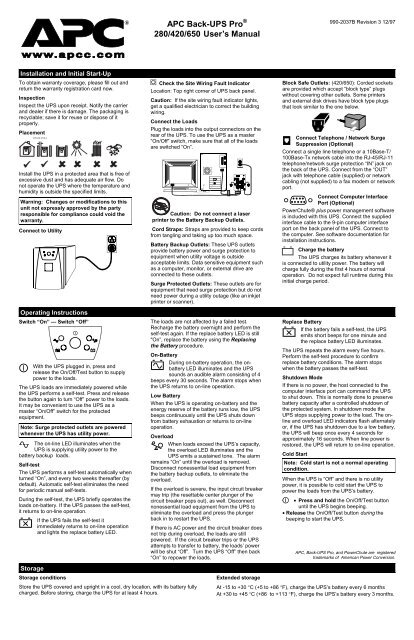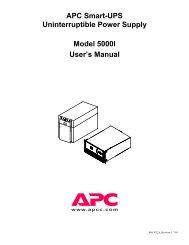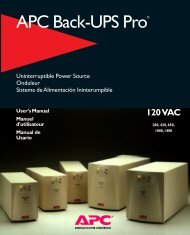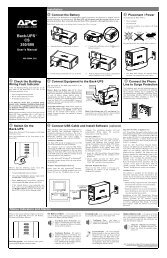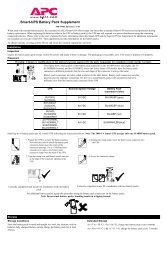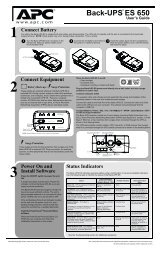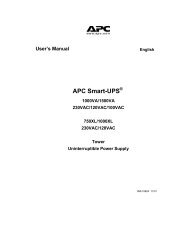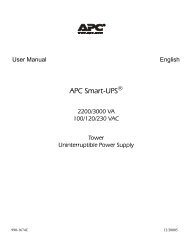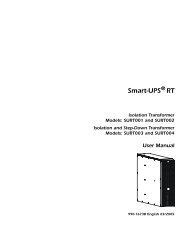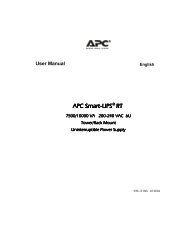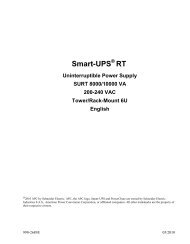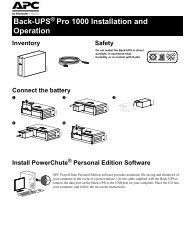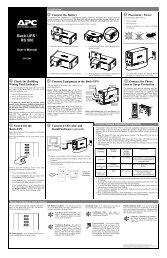APC Back-UPS Pro 280/420/650 User's Manual - APC Media
APC Back-UPS Pro 280/420/650 User's Manual - APC Media
APC Back-UPS Pro 280/420/650 User's Manual - APC Media
Create successful ePaper yourself
Turn your PDF publications into a flip-book with our unique Google optimized e-Paper software.
Installation and Initial Start-Up<br />
To obtain warranty coverage, please fill out and<br />
return the warranty registration card now.<br />
Inspection<br />
Inspect the <strong>UPS</strong> upon receipt. Notify the carrier<br />
and dealer if there is damage. The packaging is<br />
recyclable; save it for reuse or dispose of it<br />
properly.<br />
Placement<br />
Install the <strong>UPS</strong> in a protected area that is free of<br />
excessive dust and has adequate air flow. Do<br />
not operate the <strong>UPS</strong> where the temperature and<br />
humidity is outside the specified limits.<br />
Warning: Changes or modifications to this<br />
unit not expressly approved by the party<br />
responsible for compliance could void the<br />
warranty.<br />
Connect to Utility<br />
Operating Instructions<br />
Switch “On” — Switch “Off”<br />
With the <strong>UPS</strong> plugged in, press and<br />
release the On/Off/Test button to supply<br />
power to the loads.<br />
The <strong>UPS</strong> loads are immediately powered while<br />
the <strong>UPS</strong> performs a self-test. Press and release<br />
the button again to turn “Off” power to the loads.<br />
It may be convenient to use the <strong>UPS</strong> as a<br />
master “On/Off” switch for the protected<br />
equipment.<br />
Note: Surge protected outlets are powered<br />
whenever the <strong>UPS</strong> has utility power.<br />
The on-line LED illuminates when the<br />
<strong>UPS</strong> is supplying utility power to the<br />
battery backup loads.<br />
Self-test<br />
The <strong>UPS</strong> performs a self-test automatically when<br />
turned “On”, and every two weeks thereafter (by<br />
default). Automatic self-test eliminates the need<br />
for periodic manual self-tests.<br />
During the self-test, the <strong>UPS</strong> briefly operates the<br />
loads on-battery. If the <strong>UPS</strong> passes the self-test,<br />
it returns to on-line operation.<br />
If the <strong>UPS</strong> fails the self-test it<br />
immediately returns to on-line operation<br />
and lights the replace battery LED.<br />
Storage<br />
Storage conditions<br />
Store the <strong>UPS</strong> covered and upright in a cool, dry location, with its battery fully<br />
charged. Before storing, charge the <strong>UPS</strong> for at least 4 hours.<br />
<strong>APC</strong> <strong>Back</strong>-<strong>UPS</strong> <strong>Pro</strong> ®<br />
<strong>280</strong>/<strong>420</strong>/<strong>650</strong> User’s <strong>Manual</strong><br />
Check the Site Wiring Fault Indicator<br />
Location: Top right corner of <strong>UPS</strong> back panel.<br />
Caution: If the site wiring fault indicator lights,<br />
get a qualified electrician to correct the building<br />
wiring.<br />
Connect the Loads<br />
Plug the loads into the output connectors on the<br />
rear of the <strong>UPS</strong>. To use the <strong>UPS</strong> as a master<br />
“On/Off” switch, make sure that all of the loads<br />
are switched “On”.<br />
Caution: Do not connect a laser<br />
printer to the Battery <strong>Back</strong>up Outlets.<br />
Cord Straps: Straps are provided to keep cords<br />
from tangling and taking up too much space.<br />
Battery <strong>Back</strong>up Outlets: These <strong>UPS</strong> outlets<br />
provide battery power and surge protection to<br />
equipment when utility voltage is outside<br />
acceptable limits. Data sensitive equipment such<br />
as a computer, monitor, or external drive are<br />
connected to these outlets.<br />
Surge <strong>Pro</strong>tected Outlets: These outlets are for<br />
equipment that need surge protection but do not<br />
need power during a utility outage (like an inkjet<br />
printer or scanner).<br />
The loads are not affected by a failed test.<br />
Recharge the battery overnight and perform the<br />
self-test again. If the replace battery LED is still<br />
"On”, replace the battery using the Replacing<br />
the Battery procedure.<br />
On-Battery<br />
During on-battery operation, the onbattery<br />
LED illuminates and the <strong>UPS</strong><br />
sounds an audible alarm consisting of 4<br />
beeps every 30 seconds. The alarm stops when<br />
the <strong>UPS</strong> returns to on-line operation.<br />
Low Battery<br />
When the <strong>UPS</strong> is operating on-battery and the<br />
energy reserve of the battery runs low, the <strong>UPS</strong><br />
beeps continuously until the <strong>UPS</strong> shuts down<br />
from battery exhaustion or returns to on-line<br />
operation.<br />
Overload<br />
When loads exceed the <strong>UPS</strong>’s capacity,<br />
the overload LED illuminates and the<br />
<strong>UPS</strong> emits a sustained tone. The alarm<br />
remains “On” until the overload is removed.<br />
Disconnect nonessential load equipment from<br />
the battery backup outlets, to eliminate the<br />
overload.<br />
If the overload is severe, the input circuit breaker<br />
may trip (the resettable center plunger of the<br />
circuit breaker pops out), as well. Disconnect<br />
nonessential load equipment from the <strong>UPS</strong> to<br />
eliminate the overload and press the plunger<br />
back in to restart the <strong>UPS</strong>.<br />
If there is AC power and the circuit breaker does<br />
not trip during overload, the loads are still<br />
powered. If the circuit breaker trips or the <strong>UPS</strong><br />
attempts to transfer to battery, the loads’ power<br />
will be shut “Off”. Turn the <strong>UPS</strong> “Off” then back<br />
“On” to repower the loads.<br />
Extended storage<br />
990-2037B Revision 3 12/97<br />
Block Safe Outlets: (<strong>420</strong>/<strong>650</strong>): Corded sockets<br />
are provided which accept “block type” plugs<br />
without covering other outlets. Some printers<br />
and external disk drives have block type plugs<br />
that look similar to the one below.<br />
Connect Telephone / Network Surge<br />
Suppression (Optional)<br />
Connect a single line telephone or a 10Base-T/<br />
100Base-Tx network cable into the RJ-45/RJ-11<br />
telephone/network surge protection “IN” jack on<br />
the back of the <strong>UPS</strong>. Connect from the “OUT”<br />
jack with telephone cable (supplied) or network<br />
cabling (not supplied) to a fax modem or network<br />
port.<br />
Connect Computer Interface<br />
Port (Optional)<br />
PowerChute® plus power management software<br />
is included with this <strong>UPS</strong>. Connect the supplied<br />
interface cable to the 9-pin computer interface<br />
port on the back panel of the <strong>UPS</strong>. Connect to<br />
the computer. See software documentation for<br />
installation instructions.<br />
Charge the battery<br />
The <strong>UPS</strong> charges its battery whenever it<br />
is connected to utility power. The battery will<br />
charge fully during the first 4 hours of normal<br />
operation. Do not expect full runtime during this<br />
initial charge period.<br />
Replace Battery<br />
If the battery fails a self-test, the <strong>UPS</strong><br />
emits short beeps for one minute and<br />
the replace battery LED illuminates.<br />
The <strong>UPS</strong> repeats the alarm every five hours.<br />
Perform the self-test procedure to confirm<br />
replace battery conditions. The alarm stops<br />
when the battery passes the self-test.<br />
Shutdown Mode<br />
If there is no power, the host connected to the<br />
computer interface port can command the <strong>UPS</strong><br />
to shut down. This is normally done to preserve<br />
battery capacity after a controlled shutdown of<br />
the protected system. In shutdown mode the<br />
<strong>UPS</strong> stops supplying power to the load. The online<br />
and overload LED indicators flash alternately<br />
or, if the <strong>UPS</strong> has shutdown due to a low battery,<br />
the <strong>UPS</strong> will beep once every 4 seconds for<br />
approximately 16 seconds. When line power is<br />
restored, the <strong>UPS</strong> will return to on-line operation.<br />
Cold Start<br />
Note: Cold start is not a normal operating<br />
condition.<br />
When the <strong>UPS</strong> is “Off” and there is no utility<br />
power, it is possible to cold start the <strong>UPS</strong> to<br />
power the loads from the <strong>UPS</strong>’s battery.<br />
• Press and hold the On/Off/Test button<br />
until the <strong>UPS</strong> begins beeping.<br />
• Release the On/Off/Test button during the<br />
beeping to start the <strong>UPS</strong>.<br />
<strong>APC</strong>, <strong>Back</strong>-<strong>UPS</strong> <strong>Pro</strong>, and PowerChute are registered<br />
trademarks of American Power Conversion.<br />
At -15 to +30 °C (+5 to +86 °F), charge the <strong>UPS</strong>’s battery every 6 months<br />
At +30 to +45 °C (+86 to +113 °F), charge the <strong>UPS</strong>’s battery every 3 months.
Replacing the Battery<br />
This <strong>UPS</strong> has an easy to replace hot-swappable battery.<br />
Note: Please read the cautions in the <strong>APC</strong> Safety Guide.<br />
Replacement Batteries<br />
See your dealer or call the number in this manual for information on<br />
replacement battery kits. For <strong>280</strong> and <strong>420</strong> models, order RBC 2. For <strong>650</strong><br />
models, order RBC 4.<br />
Battery Replacement <strong>Pro</strong>cedure<br />
Battery replacement is a safe procedure, isolated from electrical hazards.<br />
You may leave the <strong>UPS</strong> and loads “On” for the following procedure.<br />
Note: Once the battery is disconnected, the loads are not protected<br />
from power outages.<br />
Troubleshooting<br />
1. Lay the <strong>UPS</strong> on its left side. Remove the two screws<br />
holding on the battery door and open the door.<br />
Note: It may be necessary to pull the battery door slightly<br />
toward the front of the unit in order to open the door fully.<br />
2. Gently pull out the battery by grasping the white tab.<br />
<strong>Pro</strong>blem Possible Cause Solution<br />
<strong>UPS</strong> will not turn “On”. On/Off/Test button not<br />
pushed.<br />
<strong>UPS</strong> will not turn “On” or<br />
“Off”.<br />
<strong>UPS</strong> operates on-battery<br />
even though normal line<br />
voltage is thought to<br />
exist.<br />
<strong>UPS</strong> input circuit breaker<br />
tripped.<br />
Computer interface<br />
problem.<br />
<strong>UPS</strong>'s input circuit breaker<br />
tripped.<br />
Press the On/Off/Test<br />
button to power the <strong>UPS</strong><br />
and the loads.<br />
Reduce the load on the<br />
<strong>UPS</strong> by unplugging<br />
equipment and reset the<br />
circuit breaker by<br />
pressing the plunger<br />
back in.<br />
Disconnect the computer<br />
interface. If the <strong>UPS</strong> now<br />
works normally, check<br />
the interface cable and<br />
the attached computer.<br />
Reduce the load on the<br />
<strong>UPS</strong> by unplugging<br />
equipment and reset the<br />
circuit breaker by<br />
pushing the plunger back<br />
in.<br />
<strong>UPS</strong> beeps occasionally. Normal <strong>UPS</strong> operation. None. The <strong>UPS</strong> is<br />
protecting the load.<br />
<strong>UPS</strong> does not provide The <strong>UPS</strong>'s battery is weak Charge the battery. The<br />
expected back up time. due to recent outage or is <strong>UPS</strong>'s batteries require<br />
near the end of its service recharging after an<br />
life.<br />
extended outage.<br />
Batteries age faster<br />
when put into service<br />
often and when operated<br />
at elevated<br />
temperatures. If the<br />
battery is near the end of<br />
its service life, consider<br />
replacing the battery<br />
even if the replace<br />
battery indicator is not<br />
yet lit.<br />
On-line and overload<br />
indicators are flashing<br />
The <strong>UPS</strong> was shutdown<br />
by PowerChute<br />
alternately.<br />
® plus<br />
None. The <strong>UPS</strong> will<br />
restart automatically<br />
software.<br />
when utility power<br />
returns.<br />
All indicators are<br />
Internal <strong>UPS</strong> fault. Do not attempt to use<br />
flashing.<br />
the <strong>UPS</strong>. Turn the <strong>UPS</strong><br />
“Off” and have it serviced<br />
immediately.<br />
The <strong>UPS</strong> operates Building wiring error such Have a qualified<br />
normally, but the site as missing ground or hot electrician correct the<br />
wiring fault indicator is lit. to neutral wire reversal. building wiring.<br />
On-line and on-battery Internal <strong>UPS</strong> fault. Do not attempt to use<br />
indicators only are<br />
the <strong>UPS</strong>. Turn the <strong>UPS</strong><br />
flashing<br />
“Off” and have it serviced<br />
immediately.<br />
All indicators are “Off” The <strong>UPS</strong> is shutdown and None. The <strong>UPS</strong> will<br />
and the <strong>UPS</strong> is not the battery is discharged return to normal<br />
operating.<br />
from an extended power operation when the<br />
outage.<br />
power is restored and<br />
the battery has a<br />
sufficient charge.<br />
The replace battery light Weak batteries. Allow the batteries to<br />
is illuminated.<br />
recharge for at least 4<br />
hours. If the problem<br />
persists after recharging,<br />
replace the batteries.<br />
Replacement batteries not Confirm the battery<br />
connected properly. connections.<br />
The overload light is The <strong>UPS</strong> is overloaded. Reduce the load on the<br />
illuminated or flashing<br />
<strong>UPS</strong> by unplugging<br />
equipment.<br />
For Computer Interface Port Specifications, see the <strong>APC</strong> Website.<br />
Service<br />
3. Disconnect the two wires connecting the battery to the<br />
<strong>UPS</strong>. Loosen the wires by wiggling them while pulling<br />
straight back from the battery connector.<br />
4. Connect the new battery in place of the old.<br />
Note: Small sparks at the battery connections are<br />
normal during connection.<br />
5. Place the new battery in the <strong>UPS</strong>. Use care to avoid<br />
pinching the wires.<br />
6. Close the battery compartment door and replace the<br />
screws.<br />
7. Dispose of the old battery properly at an appropriate<br />
recycling facility or return it to the supplier in the packing<br />
material for the new battery. See the new battery<br />
instructions for more information.<br />
If the <strong>UPS</strong> requires service, please do Not return it to the dealer!<br />
Follow these steps:<br />
1. Use the Troubleshooting section of the Quick Reference Guide to eliminate<br />
common problems.<br />
2. Verify that no circuit breakers are tripped. A tripped circuit breaker is the most<br />
common <strong>UPS</strong> problem!<br />
3. If the problem persists, call customer service or visit the <strong>APC</strong> Internet Website<br />
(www.apcc.com).<br />
• Note the model number of the <strong>UPS</strong>, the serial number, and the date<br />
purchased. A technician will ask you to describe the problem and try to<br />
solve it over the phone, if possible. If this is not possible the technician will<br />
issue a Return Merchandise Authorization Number (RMA#).<br />
• If the <strong>UPS</strong> is under warranty, repairs are free. If not, there is a repair<br />
charge.<br />
4. Pack the <strong>UPS</strong> in its original packaging. If the original packing is not available, ask<br />
customer service about obtaining a new set.<br />
• Pack the <strong>UPS</strong> properly to avoid damage in transit. Never use Styrofoam<br />
beads for packaging. Damage sustained in transit is not covered under<br />
warranty.<br />
• Include a letter with your name, RMA#, address, copy of the sales receipt,<br />
description of the trouble, your daytime phone number, and a check (if<br />
necessary).<br />
5. Mark the RMA# on the outside of the package.<br />
6. Return the <strong>UPS</strong> by insured, prepaid carrier to the address given to you by<br />
Customer Service.<br />
<strong>APC</strong> Contact Information<br />
USA/Canada …………..<br />
Mexico …………………..<br />
Brazil …………………….<br />
Worldwide ………………<br />
Internet http://www.apcc.com<br />
E-Mail apctech@apcc.com<br />
Specifications<br />
1-800-800-4272<br />
292-0253 / 292-0255<br />
0800-12-72-21<br />
1-401-789-5735<br />
<strong>280</strong> VA <strong>420</strong> VA <strong>650</strong> VA<br />
Acceptable input voltage 0 - 160 VAC<br />
Input voltage (on-line operation)* 81-143 VAC<br />
Output voltage * 106-127 VAC<br />
Input Over Current <strong>Pro</strong>tection Resettable circuit breaker<br />
Frequency limits (on-line operation) 47 - 63 Hz (autosensing)<br />
Transfer time 4 ms typical, blackout response time<br />
Maximum load <strong>280</strong> VA<br />
<strong>420</strong> VA <strong>650</strong> VA<br />
180 W<br />
260 W 410 W<br />
On-battery output voltage 115 VAC<br />
On-battery frequency 50 or 60 Hz, ±0.1 Hz; unless synchronized to utility<br />
during brownout<br />
On-battery waveshape Stepped sine-wave<br />
Output Over Current <strong>Pro</strong>tection Overcurrent and short-circuit protected, latching<br />
shutdown on overload<br />
Battery type Spill proof, maintenance free, sealed lead-acid<br />
Typical battery life 3 to 6 years, depending on number of discharge<br />
cycles and ambient temperature<br />
Typical recharge time 2 to 5 hours from total discharge<br />
Operating temperature 0 to +40 °C (+32 to +104 °F)<br />
Storage temperature -15 to +45 °C (+5 to +113 °F)<br />
Operating / storage relative humidity 0 to 95%, non-condensing<br />
Operating elevation 0 to +3,000 m (0 to +10,000 ft)<br />
Storage elevation 0 to +15,000 m (0 to +50,000 ft)<br />
Audible noise at 1 m (3 ft)


